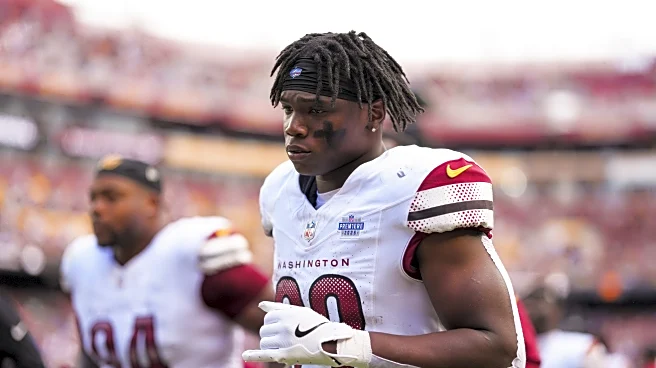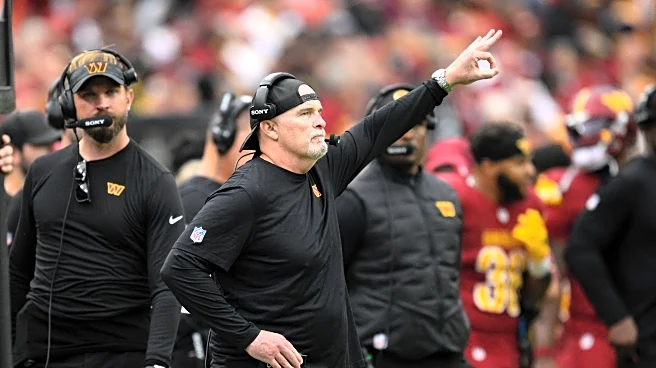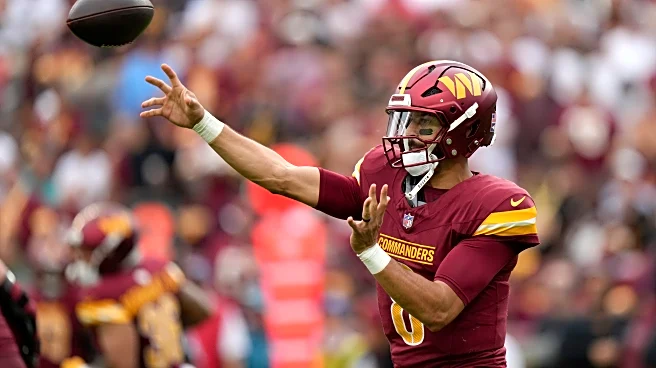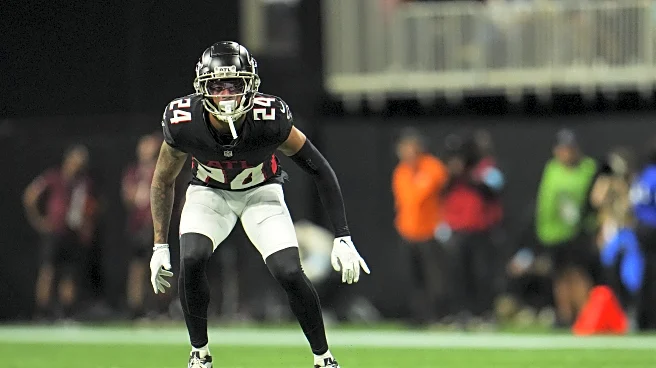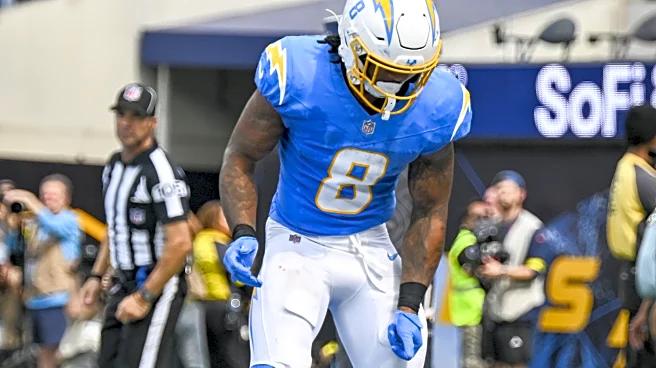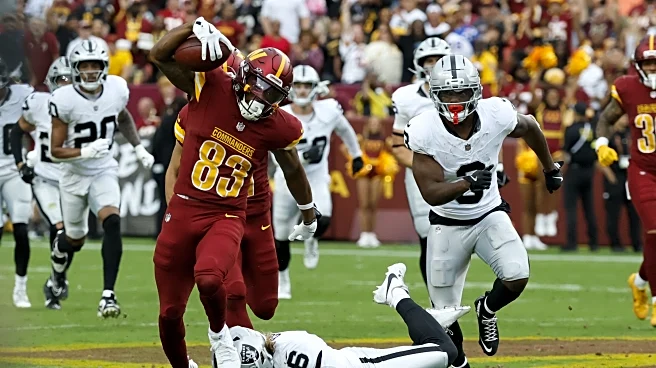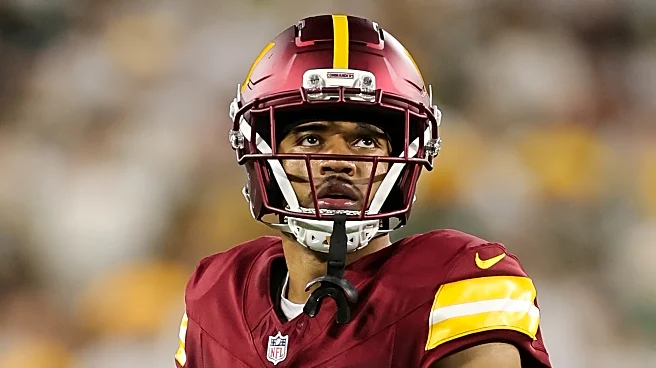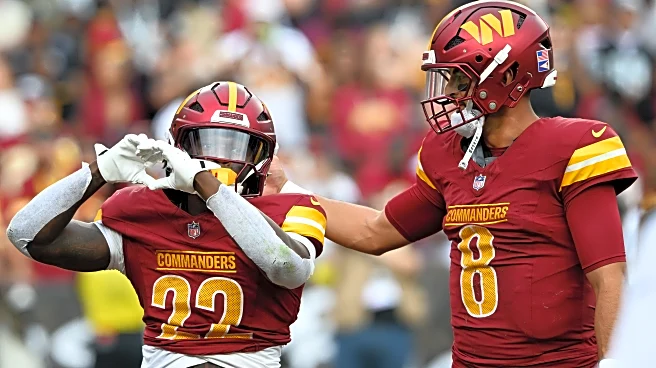The Commanders suffered a comprehensive loss to the Packers in Week 2 that was worse than the 18-27 score line indicated. The worst part was the rash of injuries to key players, including the franchise
quarterback. The beating inflicted by the Packers was exacerbate by baffling coaching decisions, most notably, the decision to abandon the run early and only come back to it after their two best run blockers were injured.
The Week 3 offered a chance to get right following a 10 day break against a 1-1 Raiders team on a short week. Dan Quinn’s coaching staff seized the opportunity to right the ship, with major adjustments to personnel grouping and the game plan. Injury replacements and young players stepped up to deliver a 41- 24 win, with the Commanders leading from the opening score and slamming the door in the second half.
The Raiders could be one of the weaker teams on the Commanders’ schedule, and there are still plenty of issues to work through. But the dominant win did a lot to erase the smell of the Week 2 hiding.
Marcus Mariota did a great job of filling in for a rehabbing JD5, for the third time since joining the team. The running game came back with a vengeance. The revamped offensive line allowed just two pressures – a remarkable improvement after giving 4 sacks and 4 QB hits to the Packers. The defense kept Geno Smith under pressure and on the ground, while holding the Raiders to just 93 rushing yards at 3.3 yards per carry, and playing penalty free. And the special teams units stepped up to the next level, delivering one of the week’s highlight plays, while containing their opponents in coverage.
Let’s take a look at how the Commanders rolled with the punches to deliver a knockout blow against the Raiders as they look to ride the momentum to a road win over the Atlanta Falcons.
OFFENSE

Marcus Mariota stepped in for the injured starter and the offense didn’t miss a beat. In fact, it was the most efficient it’s been this season at 0.220 EPA/play (NFL rank 5th), improving on the Week 1 performance against the Giants (0.155 EPA/play, rank 10th).
Mariota completed 15/21 attempts for 207 yds (9.86 Y/A), 1 TD, and 7 first downs, while taking just 1 sack for 8 yds. He ran the ball 6 times for 40 yards with 1 TD and 1 lost fumble (Rush Success Rate 50%). That effort was good for a 54.8 Total QBR, which ranked 14th in Week 3 and bettered Jayden Daniels’ best mark this season (49.2 vs Giants).
Marcus was flagged for a 10 yd intentional grounding penalty late in the 4th quarter.

Kliff Kingsbury flipped the script from last-week’s pass heavy game plan, running the ball early and often, with a 32:22 run/pass balance. The bulk of the load was carried by the RBs. While the offensive line got a lot of run blocking help from the TEs and RBs this week, they continued to struggle to open running lanes. As a group, the RBs averaged 0.52 Yards Before Contact/attempt, well below last season’s fairly mediocre average of 2.09 YBC/att. Nevertheless, the RBs did a good job of breaking tackles and creating yardage after contact.
Bill Croskey-Merritt took one snap more than “starter” Chris Rodriguez, but had the lowest rushing total, taking 8 carries for 26 yds (3.3 Y/A), 2 first downs and 1 TD. Despite the low rushing average, he was effective at getting the ball where it needed to go, with a Rushing Success Rate of 62.5%. He also caught his 1 receiving target for 5 yds.
Bill’s rushing average doesn’t do justice to his effort on Sunday. He had a total of -4 YBC across 8 rushing attempts, which comes to an average of -0.5 YBC/att. He was usually getting hit behind the line. Not surprisingly, he forced 3 missed tackles in 8 attempts.
Chris Rodgriguez had the next highest rushing total and average. He toted the rock 11 times for 39 yds (3.5 Y/A) and 1 first down. But he had the lowest Rushing Success Rate of the RBs, at a still respectable 45.5%. He was not targeted as a receiver.
Rodriguez enjoyed the most running room of the RBs, but still only averaged 1.18 YBC/att.
Jeremy McNichols took just 4 handoffs, but led the Commanders with 78 yds (19.5 Y/A) and 1 TD, thanks to a 60 yd scoring run. He picked up first downs on 2 of the other 3 runs, resulting in a 75% Rushing Success Rate.
McNichols also didn’t get much help from the blocking in front of him. He averaged 0.75 YBC/att, with a whopping 18.75 YAC/att, thanks to that long TD run, which started by escaping what looked like a certain tackle. He forced 4 missed tackles on 4 attempts.

Terry McLaurin has been steadily ramping up his production since Week 1. He was the only WR listed as a starter on Sunday, and led the Commanders in receiving yards for the first time this season with a respectable 3 receptions/4 targets for 74 yds (18.5 Y/Tgt). He was denied a TD by a bad referee call.
McLaurin also led the team in receiving productivity at an elite average of 5.29 Yds/Route Run, and had the second longest Average Depth of Target (14.0 yds). He caught 1 of 2 contested targets and averaged 7.7 Yards After the Catch/Reception. He had 1 false start penalty for 5 yards. It was his 10th penalty in 7 seasons.
Chris Moore replaced injured Noah Brown at right WR. He caught 2/2 targets for 25 yds and 2 first downs, at an ADOT of 9.0 yds. He had good productivity at 1.67 Y/RR.
Deebo Samuel was more quiet as a receiver this week, with only 2 receptions on 3 targets for 11 yards (ADOT 2 yds), with 1 forced missed tackle and 11.5 YAC/Rec. He had more impact as a runner, with 3 carries for 18 yds (6.0 Y/A) and 3 first downs (100% Success Rate). He averaged 3.0 Yards After Contact/Att with 1 forced missed tackle.
Luke McCaffrey had his best day as a Commander to date. Luke caught 3/3 targets for 56 yds (18.7 Y/Tgt) and his first career receiving TD, at an ADOT of just 4.7 yds, with 14 YAC/Rec. He achieved that production while playing just 36% of offensive snaps, making him the Commanders’ second most productive receiver at 5.09 Y/RR, in addition to having the second highest receiving yardage. In 3 games, Luke is 45% of the way toward matching his 2024 receiving total.
Jaylin Lane was not put in the best position to succeed as a receiver, with one screen pass that was sniffed out behind the line and one tough contested target at the goal line. He had a pretty miserable receiving stat line of 1/3 receptions for -2 yds. But he more than made up for it on special teams.

John Bates plays a crucial role as a blocker in both phases of the offense. His absence with a groin injury created a major vacuum. The Commanders adjusted by changing their utilization of three players in the tight end corps.
Ben Sinnott became the most utilized TE and got the most playing time he has had since Week 15 last season. He was used predominantly as a run blocker from the inline TE position, and also took 5 snaps lined up at FB. As an inline blocker, Sinnott took 14 snaps on the left side and 13 snaps on the right. According to PFF, he was the team’s third highest rated run blocker, with a 72.7 grade. He did a pretty good job of filling in for Bates.
Zach Ertz played his usual role as a receiving threat from the slot. He had the team’s third highest receiving total, catching 3/3 targets for 38 yds (12.7 Y/Tgt) at an ADOT of 10.7 yds. He was the third most productive receiver at a very good 2.11 Y/RR.
Colson Yankoff was also called on to bolster the blocking in Bates’ absence. In one game he more than doubled his offensive playing time compared to last year when he played just 7 snaps. Yankoff played 17/20 snaps as a run blocker and ran routes on the other 3. Most importantly, Yankoff took 50% of his snaps from the fullback alignment. This game marks the first time in Kliff Kingsbury’s tenure as OC that the Commanders have given significant playing time to a player in the fullback role. PFF gave Yankoff a fair to middling 56.0 run block grade.
The Commanders were not content with using just two TEs to fill in for Bates. Trent Scott was listed as a starting OT, but was used exclusively as a rotational TE in heavy subpackages, predominantly on rushing downs. Scott was deployed as an inline blocker on the left side for 12 snaps and on the right side for 7 snaps. He earned a 56.3 PFF run blocking grade. Sadly, he was not targeted as a receiver.

Following last week’s disastrous outing, the Commanders made major adjustments to the OL personnel, with new starters at both guard positions. Interestingly, they chose to stick with rookie Josh Conerly at RT, after he allowed 9 pressures and 3 sacks against the Packers.
Left tackle Laremy Tunsil was perfect in pass protection, allowing 0 pressures in 26 pass blocking snaps. That was a common theme for the OL against the Raiders. PFF gave him a slightly better than average 56.5 run blocking grade. Tunsil is well known amongst the referees. On Sunday he was flagged for illegal use of hands and holding. The holding call was declined.
Chris Paul got his first start at LG since his disastrous 2023 campaign and rewarded the team’s confidence in him with a shutout in pass protection and the team’s highest run blocking grade (82.7). He also avoided the referees’ attention.
Center Tyler Biadasz was the only Commanders’ lineman who allowed a pressure. He allowed 2 hurries in 26 pass pro reps, for a Pressure Rate of 7.7%, which is about twice the rate you’d hope to see at center. His Pressure Rate was even higher than last week (5.4%) when the Commanders threw a little more than twice as much. He has not allowed lower than 4% Pressure Rate yet this season. PFF gave him the second highest run blocking grade on the team at 74.7.
Following the dismal performance of the right side of the line against Green Bay, RG Nick Allegretti was replaced by Andrew Wylie. That seemed to shore up the pass protection, with no pressures allowed on the right side. Wylie’s run blocking graded just below average (49.9). Wylie was called for holding once in the second quarter.
RT Josh Conerly Jr kept his starting position and bounced back with a solid performance against the Raiders. The rookie RT has had a baptism of fire to start his career, facing Brian Burns, Micah Parsons and Maxx Crosby in successive weeks. If Sunday’s performance was any indication, he may be better for it. He allowed 0 pressures in pass protection and graded a little below average in run blocking (45.2). The blocking stats can’t really tell us how much he benefitted from having a steadier presence at guard to his left or an inline TE to his right on 25/58 snaps. But it couldn’t have hurt.
It wasn’t all sunshine and puppies, however. Conerly was flagged for holding twice, with one of the penalties declined.
DEFENSE

Dan Quinn is known for moving players around the defensive front. Even by his standards, the Commanders have been moving the edge defenders around an awful lot this season, particularly since starting RDE Deatrich Wise was lost to injury last week. Against the Raiders the edge alignments were like a probability cloud. And this isn’t even counting the snaps taken by DTs at DE.
Last season, Dorance Armstrong was the starting left edge, with 71% of snaps at left defensive end or OLB. This year he has taken 42% of defensive snaps at left edge and 52% at right edge. The Raiders game continued the trend, with 54% of defensive snaps taken at right edge.
Dorance was a little less productive than he has been in recent weeks at pressuring the QB, but still posted a respectable 14.3% Pressure Rate and continued his streak of 1 sack per game. Armstrong tallied 1 sack and 2 hurries in 21 pass rush snaps, to go with 3 tackles and 2 assists, with 2 TFL, and 4 total defensive stops (3-way tie for most stops on team).
Three of Armstrong’s defensive stops were against the run, resulting in a team-leading Run Stop Rate of 17.6%, a very good single-game figure for a DE.
Dorance is currently in a 3-way tie with Myles Garrett and Baron Browning for 12th most pressures among edge defenders and is in a 6-way tie for 7th most sacks with other luminaries including Will Anderson Jr, Aidan Hutchinson and Brian Burns.
Von Miller surprisingly played the most snaps of anyone on the left edge. Over recent seasons his defensive production has declined due to reduction in playing time, rather than productivity when he’s on the field. Against the Raiders he produced 2 hurries and 1 sack for an 18.8% Pressure Rate, which is very good at edge, but nowhere close to the highest on the team.
Miller made 2 tackles with 1 TFL and 2 total defensive stops, with 1 run stop (10% Run Stop Rate).
Jacob Martin split time roughly equally between left and right sides as a stand-up pass rusher. He made 1 stop against the run (7.1% Run Stop Rate) and 1 tackle assist, but recorded no pressures in the pass rush.
Javontae Jean-Baptiste made his second appearance on defense. Playing mainly on the right edge, he recorded the second sack of his career (11.1% Pressure Rate) as well as 1 tackle and 1 assist.
Jalyn Holmes made his 2025 debut after being signed to the active roster following Deatrich Wise’s injury. He generated 3 QB hurries in just 10 pass rush snaps, for a DL-leading 30% Pressure Rate. He also registered 1 tackle assist.

Daron Payne played 72 of his snaps on the interior and 28% on the edge, which is fairly typical of his usage in Whitt’s defense. He was the most disruptive player in an active defensive. He led the team in QB pressures with 2 QB hits and 5 hurries. His 29.2% Pressure Rate is insane for an interior defender, but was second among linemen after Jalyn Holmes. He didn’t sack the QB himself, but his disruption of the pocket create sacks for others.
Payne was also disruptive against the run, with 3 stops in 19 run defense snaps. His 16.7% Run Stop Rate is in the elite range for down linemen.
In more traditional terms, Payne made 4 tackles, 2 assists and 1 TFL with 1 missed tackle. According to Pro Football Reference, he was targeted once in coverage, allowing a reception for -2 yds, which counted as his fourth total defensive stop. PFF didn’t see it.
Javon Kinlaw took 37% of his snaps on the edge and the rest on the interior. He was less impactful than we have seen, recording just 1 QB hurry (4.2% Pressure Rate) and 1 run stop on an assisted tackle (4.8% Run Stop Rate).
Johnny Newton played the highest proportion of snaps at DE of the interior linemen, at 43%. He didn’t generate any pressures, but did make 2 run stops in just 9 snaps in run defense (22.2% Run Stop Rate). He made 1 tackle and 1 assist, with 1 missed tackle.
Eddie Goldman was the only DT who played exclusively on the interior and took the most snaps lined up over the center. He registered 1 QB hurry and 1 assisted tackle.

Bobby Wagner led the Commanders in total tackles (10) and solo tackles. He also made 1 TFL. Uncharacteristically, he only had the fourth most defensive stops (3, tie with Mike Sainristil) and just 1 run stop.
His biggest impact was as a blitzer. He made 2 sacks, 1 QB hit and 2 hurries on 6 blitzes for an amazing 83.3% Pressure Rate.
According to PFF, he had 1 target in 30 coverage snaps and gave up a 10 yd TD to WR Tre Tucker. That’s a bad matchup. PFR counted 2/2 rec for 26 yds and the TD.
Frankie Luvu was also impactful against the Raiders, recording 4 tackles and 3 assists with 1 missed tackle. He generated 1 QB hurry on 7 blitzes and 4 run stops on 29 snaps in run defense (14.8% Run Stop Rate).
In 24 coverage snaps, he allowed 2 receptions on 2 targets to Tre Tucker and Brock Bowers for 8 yds and 1 TD.
Jordan Magee was only on the field for 6 defensive snaps, but still managed to make 3 tackles, including 1 run stop. He was targeted once in coverage allowing a 4 yd reception.

Mike Sainristil played the most and was targeted the most of the Commanders’ CBs.
According to PFF, he allowed 5 receptions on 5 targets for 41 yards. His rate of yardage allowed was a little high for a starting CB at 1.11 Yards/Coverage Snap, but a big improvement over last week. PFR counted 6/6 receptions for 130 yds which is a lot worse than last week. Who are you going to believe?
PFR counted 3 tackles and 2 assists with 1 missed tackle; while PFF counted 6 tackles with no misses and 3 defensive stops.
Marshon Lattimore did a better job of shutting down his receivers, allowing just 1 reception on 2 targets for 12 yds with 1 PBU, and an impressive coverage efficiency of just 0.52 Yd/Cov Snap.
He made 2 tackles and 1 assist, with 1 defensive stop.
Trey Amos was perfect in coverage, allowing no receptions on 1 target in 18 coverage snaps. He came close to making his first NFL interception, but couldn’t control a tipped ball, which was recorded as a PBU.
He made 1 TFL on a pass play and missed 1 tackle. Trey is off to a very strong start. He is currently second in the rookie DB class with 2 PBUs, according to PFF, or tied in first place with 4 PBUs if you believe Pro Football Reference. Sticking with PFR, he has given up the 8th most receiving yards in the rookie DB class, which is no surprise, since he has played the 8th most defensive snaps, almost exclusively at boundary corner, which is the most heavily targeted DB position.
Noah Igbinoghene was targeted 4 times in 17 coverage snaps and allowed 2 receptions for 24 yds (1.41 Yd/Cov Snap), with 1 PBU. He made 2 tackles and 1 assist, with 1 run stop.
Antonio Hamilton played 5 defensive snaps in place of injured Jonathan Jones and recorded 1 tackle assist.

Quan Martin was the starting free safety, but split time in the box and covering the slot. He made 2 tackles with 1 miss. PFF and PFR agree that he was targeted twice in coverage, allowing 2 receptions. PFR counted 37 receiving yards, whereas PFF counted 65.
Jeremy Reaves took over as the primary strong safety, when Will Harris left the game with a fractured fibula. Reaves registered a QB hit on his only blitz. He made 2 solo tackles and 2 assists, with 1 stop and 1 miss.
According to PFF, he was targeted 4 times in coverage, allowing 3 receptions for 89 yds and 1 TD. PFR counted 3 tgt, 2 rec for 22 yds and 1 TD.
Before leaving the game in the second quarter, starting SS Will Harris made 2 tackles and was targeted twice in coverage, allowing 1 reception for 18 yds and making 1 PBU.
Tyler Owens played sparingly, and was used primarily as a big nickel, covering TEs in the slot. He played 11 snaps in coverage (9 in the slot), 6 in run defense, and 2 rushing the passer. He was targeted once in coverage and gave up an 18 yd reception to TE Brock Bowers. Owens made 1 tackle on defense.
SPECIAL TEAMS

The big story on special teams this week was Jaylin Lane earning Pepsi Rookie of the Week honors for a 90 yd punt return TD. Jaylin had his breakout game, validating what Adam Peters told him when he was drafted, with 5 returns for 127 yds (25.4 YPA), 1 TD and no fair catches. He averaged 9.25 YPA on the returns he didn’t bring back for TDs, which is pretty good by itself.
Jaylin is currently averaging 17.7 YPA on 10 punt returns, which ranks 2nd in the NFL (min 5 returns) after the guy I had hoped the Commanders would draft, Tory Horton of the Seahawks (26.0 YPA, 6 returns), who incidentally returned one for a 95 yd TD on Sunday. It was a good weekend for non-offensive TDs.
The other developing story line was that Matt Gay missed another field goal, this time from 37 yards. He is currently 3/6 on field goal attempts (50%), with 1 miss from under 50 yds. He hit under 84% on field goal attempts for the past two seasons and ranked no higher than 22nd in FG percentage among kickers with more than 20% of the maximum number of attempts.
Deebo Samuel also broke off a long return, running a kickoff back for 69 yds. He returned 3 kicks for 93 yds (31 YPA) with no fair catches. Luke McCaffrey returned 1 kick for 25 yds.
Tress Way bounced back from an injury scare, booting 3 punts for 138 yards (46.0 YPA) with 2 returned for 10 total yards (Net 42.7 YPA). Tress landed 2/3 within the Raiders’ 20 yd line.
If only there were stats to quantify how rock solid Tyler Ott was on long snaps. The eye test tells me his snaps were crisp and accurate with great spin.


We don’t talk enough about how good the Commanders’ coverage units have been under Coordinator Larry Izzo. Part of the reason for that is the lack of readily available stats on special teams coverage efficiency. We hear about individual players’ tackle counts, but what we really should be talking about is containment of receiving teams’ returns.
This week, the Commanders held the Raiders to just 110 yds on 5 kick returns (22.0 YPA) and 10 yds on 2 punt returns (5.0 YPA), which paled in comparison to their own output of 4 kickoff returns for 118 yds (29.5 YPA) and 5 punt returns for 127 yds (25.4 YPA) and 1 TD.
Six Commanders made the tackles to hold the Raiders’ return specialists in check:
Jordan Magee led the coverage units with 2 tackles. Colson Yankoff, Tyler Owens, Luke McCaffrey, Chris Moore and Chris Rodriguez had one apiece. Last year’s special teams tackle leader, Nick Bellore had an uncharacteristic miss, as did DB Antonio Hamilton.
Noah Igbinoghene drew a 10 yard holding call on a punt return at the end of the first quarter.
LAST WEEK’S POLL RESULTS
Last week I polled readers on player developments they thought were most likely to happen in the Raiders game. Here are the poll results:

The most popular choice was that Dorance Armstrong would record his fourth sack of the season, meaning 2 sacks against the Raiders. Sadly, 1/3 of poll respondents got that one wrong.
The poll options that did come true were:
Marcus Mariota throwing his fifth TD as a Commander (16.7% of votes), Andrew Wylie starting at RG (4.8%), and Jaylin Lane returning a punt more than 30 yds (1 vote, 2.4%).
Commanders fans will have to wait at least another week to see if Trey Amos gets his first pick, Dorance Armstrong has his fourth consecutive game with a sack, Bill Croskey-Merritt breaks 100 rushing yds, Terry tops 100 receiving yards, or Matt Gay plays his last game in Burgundy and Gold.
Sorry, no poll this week – platform’s not working

